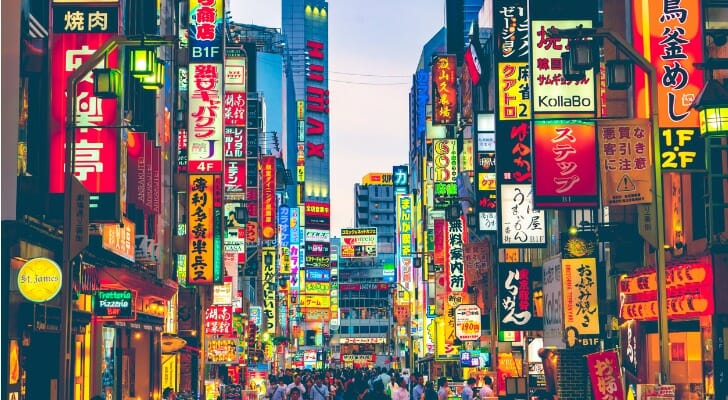 The Tokyo Stock Exchange (TSE) is the world’s third-largest exchange, with a total market capitalization of approximately $6.8 trillion. The Tokyo-based exchange lists nearly 3,800 companies. The exchange merged with another exchange based in Osaka in 2013 to form Japan Exchange Group (JPX). If you’re interested in investing on foreign exchanges consider working with a financial advisor who’s familiar with non-U.S. bourses.
The Tokyo Stock Exchange (TSE) is the world’s third-largest exchange, with a total market capitalization of approximately $6.8 trillion. The Tokyo-based exchange lists nearly 3,800 companies. The exchange merged with another exchange based in Osaka in 2013 to form Japan Exchange Group (JPX). If you’re interested in investing on foreign exchanges consider working with a financial advisor who’s familiar with non-U.S. bourses.
TSE History
The Tokyo Stock Exchange began in 1878 as a market for government bonds issued to former samurai. Trading was active until it shut down in 1947 in the wake of Japan’s defeat in World War II. It reopened in 1949 and has operated continuously since.
The TSE is the largest in Japan, accounting for the vast majority of trading in the country. There are three other exchanges, including markets in Nagoya, Fukuoka and Sapporo.
On Oct. 1, 2020, trading on the entire TSE was halted for a full day due to a technical malfunction. The problem was traced to the failure of an electronic trading system supplied by Fujitsu. In the aftermath of the trading halt, the head of the exchange resigned.
How TSE Works
Securities on the JPX are divided into sections based on characteristics of the company issuing securities. The sections include:
- First Section, the largest companies
- Second Section, smaller established companies
- Mothers, for high-growth and emerging companies
- JASDAQ Standard, for smaller emerging companies
- JASDAQ Growth, for smaller growth companies
Tokyo PRO Market is a special section of the TSE for professional investors only.
The TSE trades weekdays from 9 a.m. to 3 p.m. local time. Tokyo time is 13 hours ahead of New York time.
TSE securities are priced in Japanese yen. Each yen is valued at approximately 0.0091 U.S. dollars.
TSE Listing Requirements
The TSE has different requirements for listed companies, depending on the section of the exchange. First Section companies have the most stringent listing requirements. The requirements for listing in the First Section include:
- 800 or more shareholders
- 20,000 or more tradable shares
- Market capitalization of approximately $225 million or more
- Tradeable shares at least 35% of the listed stocks
- At least three years of operations
- At least $100 million in sales for the last year
- At least approximately $20 million in profits over the last two years
TSE Largest Stocks
TSE listed companies include some of the most recognizable corporate names in the world, especially in electronics and automobiles. The largest five companies listed on the exchange b y market capitalization are:
- Toyota Motor Corporation (7203), automobiles
- SoftBank Group Corporation (9984), communications and technology
- Sony Corporation (6758), consumer electronics and entertainment
- Keyence Corporation (6861), sensors and measurement instruments
- Fast Retailing Co., Ltd. (9983), apparel manufacturing and retailing
Special TSE Considerations
 During the second half of the 1980s, Japanese stock prices more than tripled as the Japanese economy experienced an historic boom. Rising exports and low interest rates financed skyrocketing values especially for land, which was used to leverage stock market investments. At the peak of the boom, the TSE was the world’s biggest by market capitalization. The bubble burst in 1990 and by summer of 1992 losses by investors in the Japanese stock market totaled $2 trillion.
During the second half of the 1980s, Japanese stock prices more than tripled as the Japanese economy experienced an historic boom. Rising exports and low interest rates financed skyrocketing values especially for land, which was used to leverage stock market investments. At the peak of the boom, the TSE was the world’s biggest by market capitalization. The bubble burst in 1990 and by summer of 1992 losses by investors in the Japanese stock market totaled $2 trillion.
How to Invest in the TSE
In order to directly buy and sell securities on the TSE investors must demonstrate that they are either citizens of Japan or permanent residents. With the proper certification, investors can open accounts at Japanese brokerages and trade on the TSE.
Many large TSE companies are also available as American Depositary Receipts (ADRs). These are readily available and traded on U.S. exchanges.
Another and more convenient way to invest in the Japanese stock market is through exchange-traded funds that track some of the many indices based on the TSE. The best-known is the JPX-Nikkei index, which consists of 400 large companies on the TSE. The Nikkei mid and small cap index focuses on smaller TSE listed companies.
TOPIX is another TSE index that is broader than the Nikkei. It is a market cap-weighted index calculated from all the stocks on the TSE First Section of large companies.
Bottom Line
 The Tokyo Stock Exchange is the dominant stock exchange in Japan and one of the largest in the world based on market capitalization. Its listed companies include some of the world’s most recognizable brands, especially in electronics and automobiles. Many investors participate in the TSE by investing in exchange-traded funds that track the JPX-Nikkei 400, the broader TOPIX, or one of the other TSE-based indices.
The Tokyo Stock Exchange is the dominant stock exchange in Japan and one of the largest in the world based on market capitalization. Its listed companies include some of the world’s most recognizable brands, especially in electronics and automobiles. Many investors participate in the TSE by investing in exchange-traded funds that track the JPX-Nikkei 400, the broader TOPIX, or one of the other TSE-based indices.
Tips on Investing
- If you would like to make investing in Japanese stocks on the Tokyo Stock Exchange part of your investment plans, a financial advisor experienced in navigating international stock markets is likely to be of significant assistance. Finding one doesn’t have to be hard. SmartAsset’s free tool matches you with financial advisors in your area in five minutes. If you’re ready to be matched with local advisors who will help you achieve your financial goals, get started now.
- Whether you’re considering getting started with investing or highly experienced, an investment calculator can help you figure out how to meet your goals. It can show you how your initial investment, frequency of contributions and risk tolerance can all affect how your money grows.
Photo credit: ©iStock.com/CHUNYIP WONG, ©iStock.com/GCShutter, ©iStock.com/franckreporter